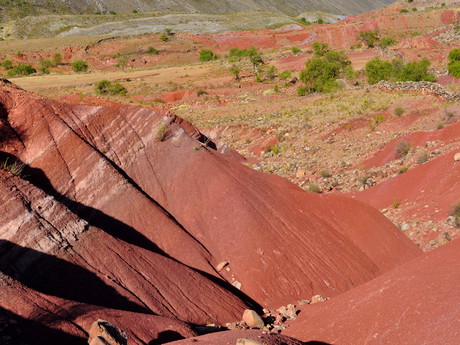Bolivia – Torotoro National Park

The article is brought to you:
The only buses depart at 6 a.m. Therefore, we need to hurry. A cab driver makes use of it. Therefore, we take a two minute ride with him to the adjacent district. It is dark there. We get off at a garage. He says to a group of people idling at a van that he brings two foreigners. For this he receives 15 BOB (cca 2€) and put a smile on his face.
The road is pleasant. There is a lot of energy in the land upon which sun is rising. I haven't slept much in the night bus so I catch a bit of sleep. The roads are dusty. They are layed out with stone in the villages we ride through. Bumping is annoying even if one is not trying to sleep. I enjoy the view. The land around the Torotoro national park is parched. Riverbeds are dry, the land is wavy. Torotoro village is situated 140 kilometers from Cochabamba at 2000 meters. It is pleasantly warm here even after dark. There are several dozens of buildings in the village, half of them being hotels, restaurants, or the Torotoro National Park administration. Some structures are being renovated. New ones for the purpose of tourism are being built as well. They are quite well prepare for tourists in the coming years.
You have to pay 35 BOB fee to enter the national park. The ticket is valid for 4 days. Howeve,r we don't like the fact that we can enter the park only with a guide and we have to pay for him (100 BOB for a group of six). I don't like to walk with the guide. But there is nothing we can do and we are already here. Moreover, we are getting used to those unnecessary fees in Bolivia. The same goes for the fee for leaving the bus terminus (1–4 BOB).
We are allowed to go to Cemeterio de Tortugas today withotu the guide. It is abtou 3,5 kilometers from the village. The same ticket is valid to enter the cemetery. Once again, it is dried red plain on wavy landscape. Before, there used to be animal fossils. Now these are mostly all picked up.
At half past seven, we are waiting for our guide to arrive before the park's administration center. We talk to other people with who we will form a group. There are seven of us eventually. The maximum count. First of all we go behind the village across dried river creek to rocky slope. There are several dozen dinosaur footprints. The guide talks about them in Spanish.
We proceed to the entrance control at the Torotoro National Park. It covers total area of 165 km2. As now it is the period of drought we walk through the river creek and waterfalls. The guide shows us another dinosaur footmark which is almost one meter long. The dinosaurs lived there about 150 million years ago. There are hundreds of petrified bones and footprints.
We move on to the scenic spot above the canyon and then we continue to its heart. We climb down dozens of steps, about 200 elevation meters in total. Then we reach a small waterfall. The road ends here. The guide sits down and says that we are taking break now. Half an hour later, we go back the same road and across the meadow we return to the park administrative buildings. The tour takes four hours and the route's length is 10 kilometers.
We visited some villages around and a cemetery in the afternoon above one of the village. Uprooted crosses, dried grass, waving ribbons and trash. It seems bit decayed. However, it is quite distinctiv and it fits well into its surroundings. Extinct dinosaurs, drought, and harmony. There is a Women's center below the cemetery. All kids of folk-themed things are made there such as scarves, bags, bracelets, caps, and so on. Everything is very colorful, of course. We are about to visit several typical paved narrow streets, however, it is so cold we run away back to the hotel. We return to Cochabamba on the next day's afternoont. Colectivo was supposed to depart at 10 but we set off at eleven thirty eventually. Locals are happy to get away from the city at all. So no one makes a fuss about departing late. So do we.
GPS: 18°05'00.0"S 65°47'00.1"W (the national park)
Text and photos: Tomáš Novák
| Discussion at the article (0) |
Related Articles

Paraguay – places near the capital

Paraguay, Asunción - peaceful capital city

Bolivia – Santa Cruz de la Sierra

Bolívia – metropolis La Paz

Bolivia, Samaipata - a peaceful village

Bolivia – the beautiful city of Sucre

Bolivia - the colonial city of Potosí

Bolivia – Uyuni and Salt Pan

Bolivia – Coroico Village

Bolivia – Copacabana and Isla del Sol

Bolivia, Cochabamba – Lets Go to Central Bolivia
Related Photogallery

Bolivia – The Heart of South America
Guide:
Important Information:
![]() Information and warnings on travelling abroad is to be found HERE.
Information and warnings on travelling abroad is to be found HERE.



































